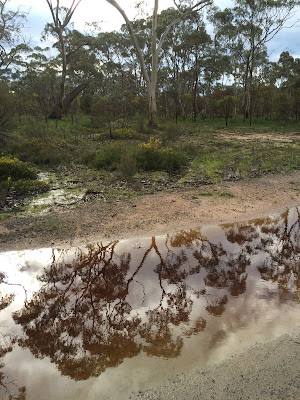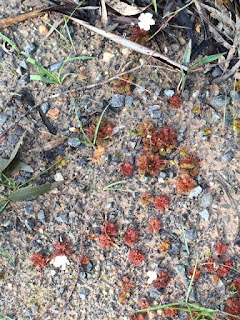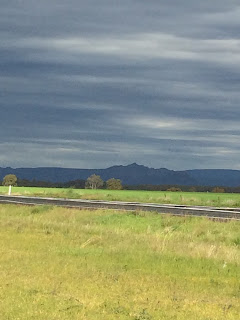Classified as: Reflective journal, participant reflections, history and discourse, observations
Edited and updated 22 August for the reasons outlined in the section on ethical considerations at the end of this post.
 |
| Beautiful 'reflections' on the roadside verge |
On 9th August I went to Wimmera PCP for my final presentation and feedback session. It was a really good visit that has inspired a lot of ideas for me.
Bruno Latour, in 'Writing Down Risky Accounts' (2005) says that social life is always complex and "messy" and that a good report should be able to elicit “networks of actors” and capture “energy, movement and specificity”.
I think this blog has captured some of the 'messiness' of social life and social research, but I don't think this (or my other notebooks or journals) has entirely captured the complexity, and the interconnections. So, as this is likely my last formal meeting with research participants before I finish my thesis, I would like to try a pictorial essay to capture some of the complexity of colour, movement, networks and connections.
I will possibly try to do something similar for the two previous feedback sessions, but as they are a while ago, I won't be able to capture so much.
In this essay, I am drawing on my notes and observations from the meeting. The essay thus uses information provided by participants at the meeting, but I haven't included information that could identify individuals, and any mistakes or misrepresentations are my responsibility. There is a discussion of ethical considerations at the end of the post. I'm using photos I took after the meeting, and
some publicly available images. In this writing I am drawing on knowledge from my previous studies in history and on general sources such as Wikipedia, so this essay should be seen only as a 'think piece' at present. It is also a draft for some further writing I will be doing in the thesis, where it will be fully referenced.
 |
| Where we met in Horsham (image from Google*) |
|
I gave the
presentation at the meeting of the Health Promotion Network. There were eight people present and two linked in by videolink. All were women. (There had also been two men present, but they had to leave before my presentation).
After the presentation, people talked about the challenges of health promotion, such as engaging 'hard to reach groups'. They also talked about community gardens, including this one:
Other gardens in the area include a school garden and a community garden at Horsham North, and another that involved members of the
local Karen community. The gardens have had different levels of success. People in disadvantaged areas may be reluctant to get involved. On the other hand, a network member commented about how people from the Karen community are very actively involved in their local garden and use the vegetables, and how mainstream Australian culture seems wasteful by contrast.
At the Warracknabeal garden, organisers have been making soup and giving it to local people. The community garden is in a central spot in the town, which probably makes it easier to engage people. There are some very engaged community members, one of whom also got some local youth involved recently. Similarly, some of the teachers at Horsham North Primary School are active in the school garden.
There was some other interesting public information that I became aware of as a result of attending the meeting. The regional Office of Health is planning a 'Prevention Exchange' forum in the area. NAIDOC week had recently been held in Horsham, with a range of activities.
I was also interested to learn that lentils are an important crop grown in this region.
As Latour might say, the diversity of topics discussed in most meetings illustrate some of the apparent "messiness" of social life. Latour is not using "messiness" in a pejorative sense (and I do not mean it in that way) but in the sense that when researchers try to record complexity it sometimes seems 'messy', because there is so much going on in most social situations. Underneath the variety of topics I've referred to here there are important themes, illustrating how social determinants, ecology, culture, everyday life and health connect, and are shaped by history. Below are some photos from my visit, and some history, exploring some of these themes further.
 |
| Bush near Horsham after the rain |
Often along the roadsides in regional areas, there are revegetated areas of natural bush, or remnant bushland that has not been cleared.
For contemporary Australians, even city dwellers, just by stopping beside the road as we drive from place, we can imagine something of what the land was like when Indigenous people lived here, before the white invasion.
No doubt it was different in Indigenous times when areas may have been regularly cleared by 'fire stick farming', but we can get some sense of the past.
The current day Wimmera and surrounding areas were home to the
Wotjobaluk, Jaadwa, Jadawadjali, Japagulk and Wergaia peoples. They obtained their food, building materials and other resources from the indigenous plants and animals of the land and had done so for thousands of years.
 |
| Raindrops in the bush |
|
|
|
|
Some of the foodstuffs included animals such as kangaroos and emus, fish and eels, but they also had a wide variety of plant foods. Tuberous plants were a key source of vegetable food, including the Yam Daisy, one of the key food sources in this area. Women gathered it using their digging sticks, but also leaving enough in the ground to ensure they grew again next season.
 |
| Murnong or Yam Daisy (photo: A J Brown for VRO) |
|
|
|
 |
| Small plants on the roadside verge near Horsham |
 |
| Wattle on the road near Horsham |
Wattleseed was also an important food source for Indigenous peoples. Many
wattles have edible seeds, although we don't know now the full range of
which seeds are edible and which are not.
 |
| Cleared and cultivated paddock near Horsham |
When white people came to this area, first as large scale squatters and then as smaller scale settlers, they cleared the land and introduced imported animals such as sheep and cattle, and started broadscale farming of crops for trade and cash, rather than for local subsistence.
The
dispossession of Indigenous people was also a violent process. There
were numerous massacres in the present day Wimmera area. Historically this was an invasion by a white society hierarchically structured by class and gender, ruled largely by white men largely from middle or upper class backgrounds. Closer settlement and soldier settlement later allowed people from working class backgrounds to gain some land, but it was still a hierarchical and patriarchal society, in which the production of cash crops or livestock for capitalist trade and export formed the economic basis, and people aimed for individual ownership of land and acquisition of resources.
This was in contrast to Indigenous society, which was generally
egalitarian in sharing ownership of food and resources, and in which people were seen to have shared responsibilities to the land rather than individual rights to profit from it.
White people rationalised the dispossession of Indigenous peoples by saying that they were 'cultivating' the land and making better use of it than Indigenous peoples had, however industrial scale farming has major ecological impacts. These impacts are not just the dispossession and destruction of people and other species, but also the impacts on soil fertility and the high levels of carbon emissions associated with current industrial farming.
Industrial scale farming requires structures of machinery production, storage and transport, illustrated by these pictures of grain silos and fuel tankers in Horsham.
One of the final consumer products of farming within a capitalist industrial society is of course fast food! Horsham has its share of fast food outlets, so a farmer who has spent the day on the tractor working to produce a cash crop of lentils, or wheat, or other foods, could then drive in to town to buy a hamburger.
So on the one hand, here is industrialised capitalist society which has become dominant in Australia over the last 230 years since the white invasion began. Cash crops of grain or legumes, and livestock, are grown on broadscale farms and transported over long distances to be sold to companies which package them or transform them into consumer goods such as hamburgers (or lentil burgers!), to be sold in supermarkets and fast food outlets. Correspondingly, cars, farm machinery, fuel and fertilisers are imported, or manufactured elsewhere in Australia, and transported over the same long distances to the farms.
Historically, this has replaced a society in which people walked over the land that gave them nearly everything they needed (there was some long distance trade in Indigenous societies). Indigenous societies had shared ownership of land, were relatively egalitarian and, although they affected the landscape, for example through the use of fire, lived sustainably for thousands of years. Industrial capitalist societies produce vast amounts of comforts and consumer goods, but are deeply unequal, and in their present form, ecologically unsustainable.
Health promotion network members can be seen as located at the intersection of these differing social forms. The network includes Indigenous organisations and Indigenous members as well as members of the farming families and the regional township populations created by white industrial society. Network members look after the health and wellbeing of local people. They work to make their local community more inclusive, bringing people together around projects such as community gardens, which encourage healthier and more sustainable ways of eating and living.
But great unresolved issues still underly this work. These issues can be represented through looking at food and transport: can we continue with societies that are based on individual ownership, profit and inequality, and which are making us unhealthy, through sedentary lifestyles and fast food production, and putting our ecology at risk, through carbon emissions and destruction of local environments and species? Or can we learn from societies that were based on principles of communal ownership, respect for land and sharing of resources, but to many people now would be almost unthinkable as a way to live? Local health promotion workers are doing great work within these contested fields, but my contention is that health promotion as a discipline has to engage more directly with these questions about what kind of society we want, and how we can live in ways that are fairer and more sustainable, but potentially involve huge disruption to taken-for-granted social and economic arrangements?

Finally though, the combination of cleared land and natural landscapes is sometimes very beautiful.
Ethical considerations: This part of the project has been
approved by the Monash Ethics committee on the understanding that
participants are providing information anonymously and discussion
is not being taped. I gave participants a project information sheet but
they did
not sign individual consent forms for individual information to be
used. Therefore I can only report my observations in a general way,
rather than in a way that links information to individuals. The
participants of
course know who they are and probably can remember who said what, but I
can't record or report anything that would indicate that. In fact, even
if new participants had signed consent forms, as previous participants
did, the
forms would have specified that information would not be reported in a
way that could be linked to a particular individual. I am not able to
say, for example, that 'a health promotion worker from a community
health service in xx municipality said such and such', because that
could potentially identify somebody, even though I did not use their
name.
Clearly this means that this report - and
anything I publish on the research - can't always include the 'specificity' of actors
that Latour is referring to above, and indeed academic writing can be a
bit boring partly for this very reason. More broadly, ethical processes that
have often been designed particularly to protect participants from certain
kinds of risks in medical research - such as invasive procedures, or the
publication of personal health information - can in some ways
conflict with other ethical considerations in community based
participatory research. For example, the requirement that research
participants are anonymous while I, as the researcher, am named, carries a
risk that I will be seen as the 'author' of all the ideas in this
project, whereas clearly many of the ideas come from participants.
Community
based participatory research is of its nature a shared project, but
formal academic processes and ethical requirements carry a
risk that the academic researcher is privileged. I have done a lot of
work on this project and put a lot of thought into it, and I expect and
hope to get credit for this. I think, however, there also need to be
processes, including ethics processes, to ensure that research
participants, as
well as academic researchers, are acknowledged as 'authors' of the
knowledge created by research. I'm not sure how to do this, but maybe
there could be a form of report or article which gives research
participants, if
they wish, the opportunity to state who they are and how they have
contributed to the
research. Again, I'm not sure which journals would (or do) publish such
articles but it is worth thinking further about.
I rewrote this post on 22 August because I felt that I had gone a bit beyond where I should have in using some information from the meeting that was not directly related to my presentation, and that in using Latour's word "messiness" it might have sounded as if I was suggesting the meeting was 'messy' when that was not what I intended! Some of the risks of participant action research are illustrated here, I guess.
---
*
acknowledged according to Google permissions







